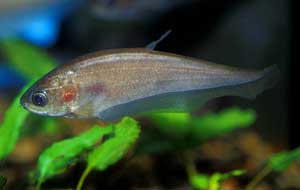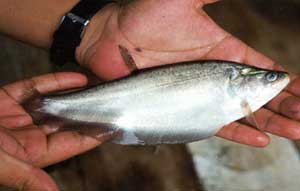 |
Snakehead Fish (Photo: 4so9) |
The meat of the snakehead fish is delicious and can be used to prepare many high-end dishes for export. Snakehead fish live in river mouths, canals, ponds, lakes, and rice fields. They can tolerate water environments with low oxygen levels and pH, and can thrive in brackish coastal waters.
All water bodies in the Mekong Delta region have snakehead fish, especially in low-lying areas. This species is omnivorous, primarily feeding on insects, crustaceans, mollusks, fry, zooplankton, and the roots of aquatic plants.
Snakehead fish have low growth rates; at one year old, they typically measure around 16 cm in length and weigh 40-60 grams each. When raised in ponds, they can reach 100 grams after 12 months.
Pond Requirements:
The pond should be sized between 100-400 m2 or larger; the pond banks must be sturdy, and the bottom should be flat. It should have an active drainage system, with water pH between 7-8 and dissolved oxygen greater than 3 mg/liter, and a water depth of 0.8-1.2 m.
Drain the pond and leave a layer of mud 15-20 cm thick; clean the surrounding area of weeds, fill any holes to prevent leaks, and then apply lime at a rate of 10-15 kg per 100 m2. Let it sunbathe for 2-3 days before filling the pond with water through a filter.
Choosing Stock for Farming:
Select fish that are consistently sized, not deformed, and healthy without injuries. Introduce the fish into the pond in the early morning or late afternoon.
The stocking density should be 5-10 fish per m2.
Feeding:
Feed the fish minced shrimp or live shrimp released into the pond. You can also feed them with flour, bran, mixed with fish meal at a ratio of 30% fish meal + 70% bran. It is advisable to feed the fish using platforms to monitor and adjust the amount of food accordingly. The feed amount should be 5-10% of the fish’s weight. Feed twice daily, as fish are most active at night; in the morning, provide 1/3 of the daily feed, and in the afternoon, 2/3 of the daily feed. Monitor the feed daily to ensure adequacy, observe fish activity, and periodically replenish fresh water for the pond.
Harvesting:
Fish raised for one year can reach weights of 80-150 grams, at which point harvesting can begin. Due to their nature of hiding and burrowing in structures, catching snakehead fish with a net can be difficult. The best harvesting method is to drain some water, pull the net to catch a portion, and then drain the water completely to catch the remaining fish.
Disease Prevention and Treatment:
 |
Snakehead Fish (Photo: 4so9) |
Healthy fish typically gather in schools, hiding among substrates, gulping air vigorously, and diving quickly. When the fish are swimming erratically and surfacing slowly, it is a sign that they may be sick.
Common Diseases in Snakehead Fish:
– **Water Mold Disease**: The fish’s skin shows grayish-white patches with soft fungal strands that grow in a tangled mass resembling cotton, visible to the naked eye.
Treatment: Soak the fish in a 2-3% saltwater solution for 5-10 minutes.
– **Flagellate Disease**: The fish’s skin appears gray, and the body has a slimy, slightly cloudy mucus.
Treatment: Soak the fish in a 2-3% saltwater solution for 5-15 minutes or CuSO4 at a concentration of 2-5 ppm for 5-15 minutes, or spray CuSO4 at a concentration of 0.5-0.7 ppm directly into the pond.
– **White Spot Disease**: The fish’s body is covered with small white spots visible to the naked eye, and they float lethargically on the water’s surface. Use CuSO4 to spray into the pond for treatment.
Note: Before using medication to treat fish diseases, it is advisable to reduce the water level in the pond to about one-third of its capacity before adding the medication.



















































